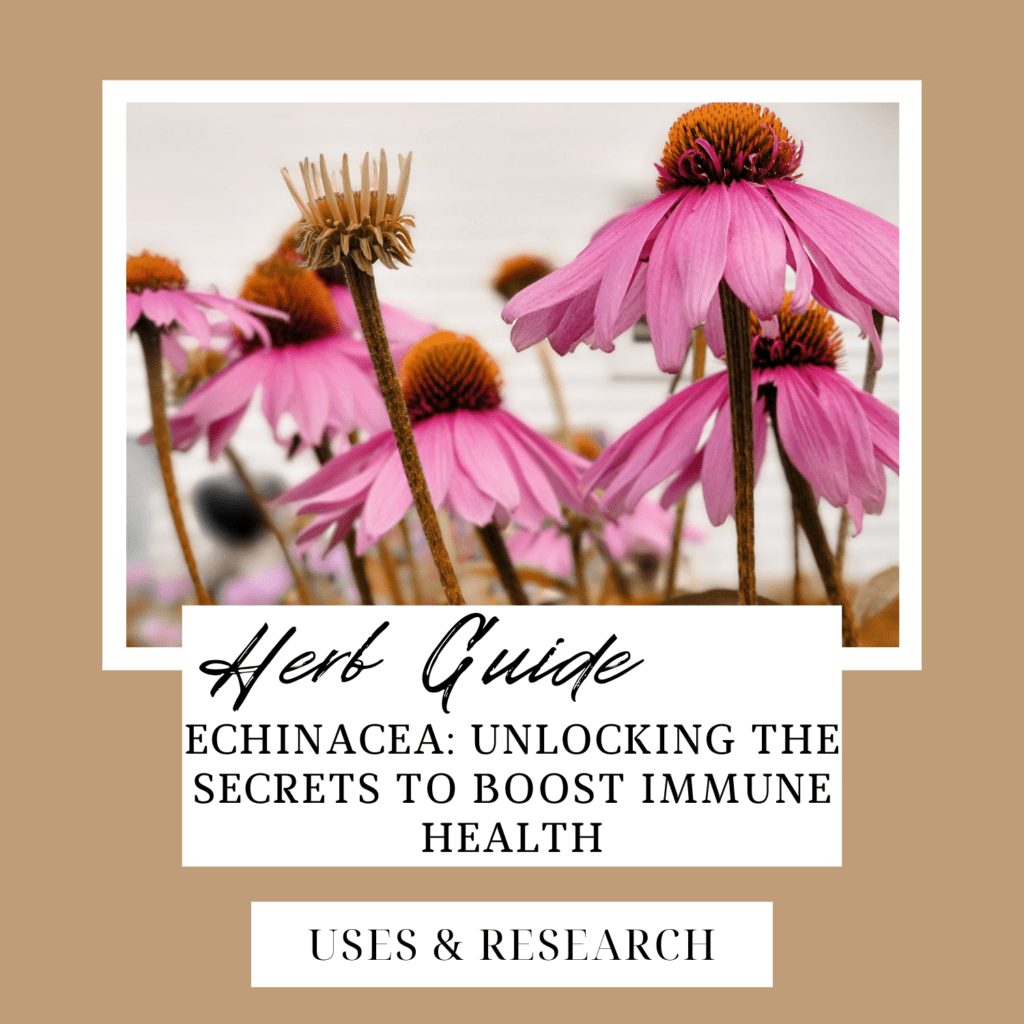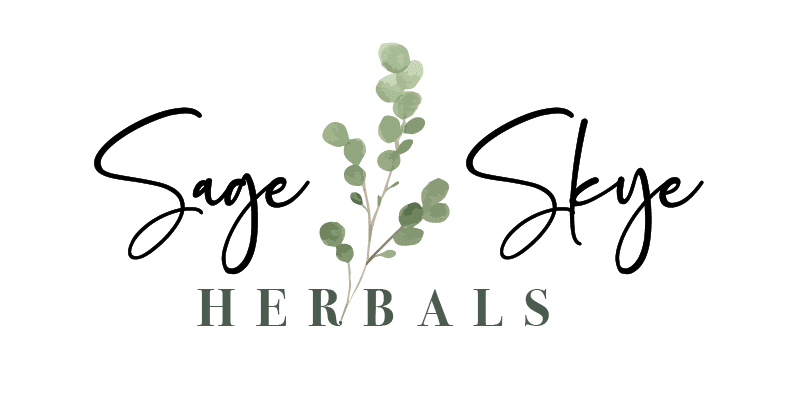
Echinacea, Purple Coneflower
Binomial Names: Echinacea angustifolia, Echinacea purpurea, Echinecea pillida (Asteraceae)
These plants are native to North America and are characterized by their striking purple or pink petals surrounding a spiky central cone. Echinacea plants have long been used in traditional medicine by indigenous peoples, particularly Native American tribes, for their purported medicinal properties.
It is one of the most researched herbs and is used and marketed in numerous health-boosting products. There are many varieties of the Echinacea plant but three are typically used for medicinal purposes These include E. angustilolia, E. purpurea, and E. pallida. The E. angustilolia and E. pallida variety are overharvested so it’s best to grow your own or use the E. purpurea variety for your preparations.
Whenever you are feeling under the weather Echinacea is a great herb to use if you have it on hand. It is an immune modulator and antiviral so incorporate it into your routine at the beginning of a cold and take throughout until you feel better.
According to Rosemary Gladstar; Echineceas’s effectiveness decreases when used continuously so it’s best to be used when needed. Other herbs can be used for immune system support during the cold and flu season like the fan favorite elderberry!
Parts Used: Flower, Roots, Leaves (fresh and dried)
Key Constituents: Alkylamides (isobutylamides), Caffeic acid esters (echinacoside and cynarin), Polysaccharides
Energetics: Cooling and drying
Key Actions: Antiseptic, antiviral, immune modulator, alterative, and lymphatic
Echinacea Uses and Research
- Immune System Support
Echinacea purpurea has a worldwide reputation for its immunomodulatory and anti-inflammatory properties, capable of modulating of various immune system pathways. There are different classes of secondary metabolites of the plant showing immunostimulatory activity, such as alkamides, caffeic acid derivatives, polysaccharides, and glycoproteins (5)
- Acne and Skin Infections
Echinacea has been used to treat various skin infections for many years. According to this study, it can also help with the bacteria that cause acne. The herbal extract readily killed a standard laboratory strain of the bacterium and several clinical isolates. In cell culture models of human bronchial epithelial cells and skin fibroblasts, P. acne induced the secretion of substantial amounts of several pro-inflammatory cytokines, including IL-6 and IL-8 (CXCL8), as determined by means of cytokine-antibody arrays. However, the E. purpurea completely reversed this effect and brought the cytokine levels back to normal (6).
- Sore Throat
Echinacea can be used alone or in conjunction with other herbs to aid in sore throat relief. In this study, the echinacea/sage treatment exhibited similar efficacy to the chlorhexidine/lidocaine treatment in reducing sore throat symptoms during the first 3 days (P(x < Y) = .5083). Response rates after 3 days were 63.8% in the echinacea/sage group and 57.8% in the chlorhexidine/lidocaine group. (7)

Folklore and Magick Properties
In some Native American cultures, echinacea was revered as a powerful talisman for warding off illness and promoting health. It was believed to strengthen the body’s natural defenses and protect against evil spirits and disease.
Carrying Echinacea will provide inner strength during trying times. It can also be grown around the house or brought into a house and placed in a vase to draw prosperity into the home and protect the family from suffering from poverty (2)
In the mid-1800s the American Eclectic physicians began to use echinacea and its use spread to Europe, where it gained even more popularity. By the beginning of the 20th century, it was one of the most frequent plants used herbal medicines in the United States, which eventually led to the widespread overharvesting of this wild perennial. Thanks to the conservation and public education efforts of the United Plant Savers, cultivated echinacea is now available for widespread use in many regions of the world (3)
Suggested Preparations
Infusion– Steep ½ tsp in hot water and drink up to 3 times a day
Decoction- Simmer 5-6 grams of root per cup of water; cover for 20/30 minutes.
Tincture– Fresh Root for E. angustifolia, fresh herb for E. purpurea (1:2, 95% alcohol); dried root for E. angustifolia, dried herb for E. purpurea (1:5, 60% alcohol); 1-5ml 3-6 times daily. (Easley and Horne p.225)
Topical Use- A standard decoction or tincture can be used as a wash or compress. (Easley and Horne p.225)
Capsules– Powder root, can take a 500mg capsule 3 times daily for a cold.
Safety and Precautions
Echinacea is nontoxic and mostly harmless. Use very cautiously if you have an autoimmune disorder. High-quality preparations of echinacea can cause excessive salivation and a scratchy, tingling sensation in the throat. (Easley and Horne p.225). Always speak with your healthcare provider before using and check any interactions with prescription medication. Work with a registered clinical herbalist for a holistic plan of care.
People with tuberculosis, leukemia, diabetes, connective tissue disorders, multiple sclerosis, HIV or AIDS, any autoimmune diseases, or, possibly, liver disorders should not take echinacea. There is some concern that echinacea may reduce the effectiveness of medications that suppress the immune system. For this reason, people receiving organ transplants who must take immunosuppressant medications should avoid this herb (4)
Disclaimer: These statements have not been evaluated by the Food and Drug Administration. This product is not intended to diagnose, treat, cure or prevent any disease.
Sources
- Easley, Thomas, and Steven H. Horne. The Modern Herbal Dispensatory: A Medicine-Making Guide. North Atlantic Books, 2016.
- https://magickalspot.com/echinacea/
- https://www.traditionalmedicinals.com/blogs/herb-library/echinacea
- https://www.mountsinai.org/health-library/herb/echinacea#:~:text=Several%20laboratory%20and%20animal%20studies,%2C%20antiviral%2C%20and%20antioxidant%20effects.
- Barnes J, Anderson LA, Gibbons S, Phillipson JD. Echinacea species (Echinacea angustifolia (DC.). Hell Echinacea pallida (Nutt.) Nutt Echinacea purpurea (L.) Moench): A review of their chemistry, pharmacology and clinical properties. J Pharm Pharmacol. 2005;57:929– https://pubmed.ncbi.nlm.nih.gov/16102249/
- Kim SS, Kim JY, Lee NH, Hyun CG. Antibacterial and anti-inflammatory effects of Jeju medicinal plants against acne-inducing bacteria. Journal of General and Applied Microbiology. 2008;54(2):101–106- https://pubmed.ncbi.nlm.nih.gov/20830697/
- Schapowal A, Berger D, Klein P, Suter A. Echinacea/sage or chlorhexidine/lidocaine for treating acute sore throats: a randomized double-blind trial. Eur J Med Res. 2009 Sep 1;14(9):406-12. doi: 10.1186/2047-783x-14-9-406. PMID: 19748859; PMCID: PMC3351972.- https://www.ncbi.nlm.nih.gov/pmc/articles/PMC3351972/







One Comment